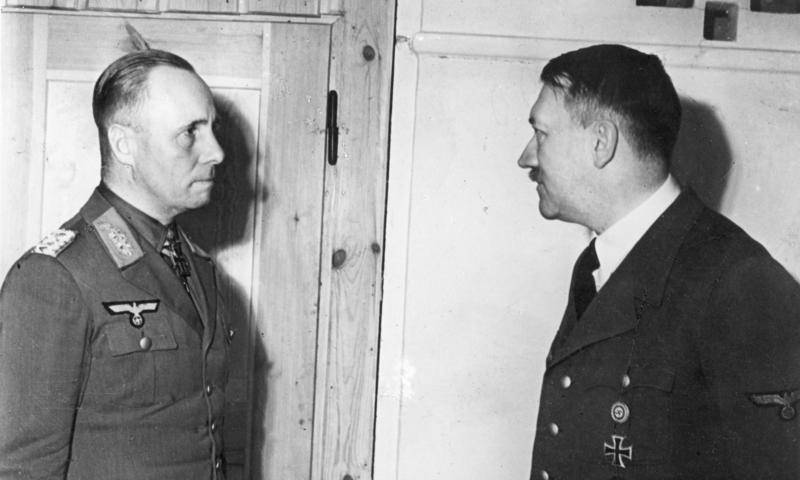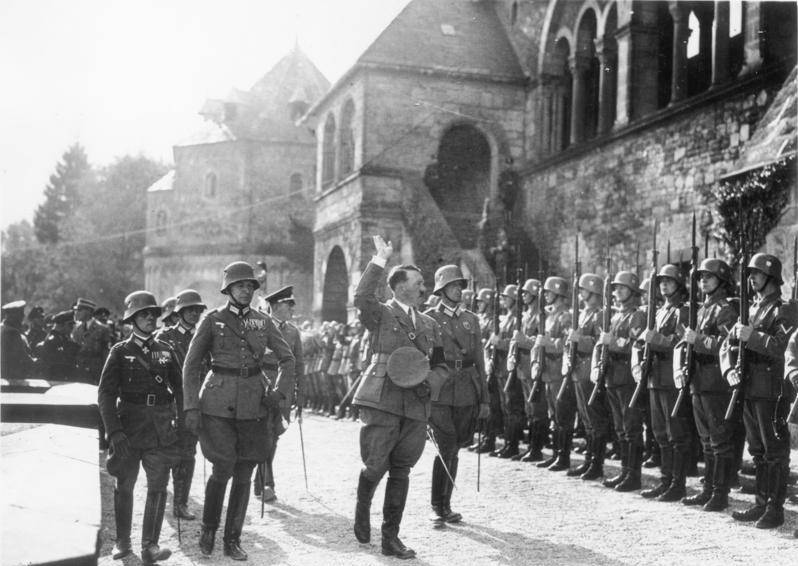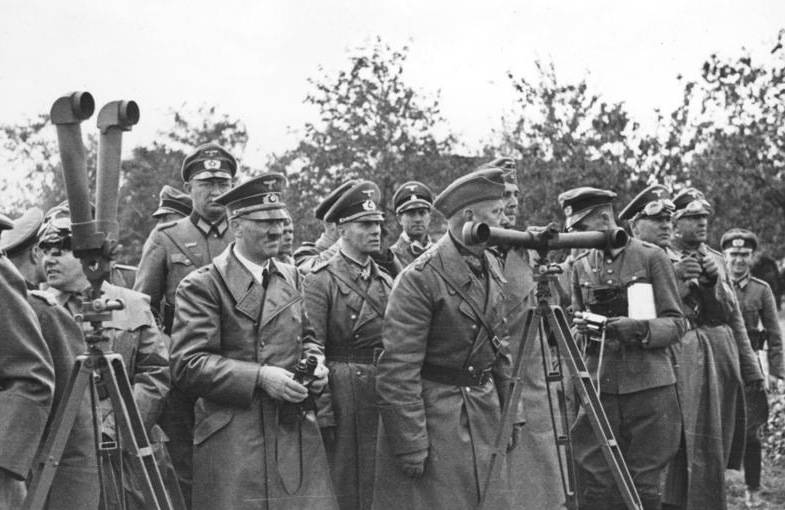Adolf Hitler literally trusted Erwin Rommel with his life. He never could have expected that in 1944, the "Desert Fox" would join a conspiracy to assassinate him.
Erwin Rommel is remembered today as one of the “good Nazis” who tried to kill Adolf Hitler. The short version of the General’s history is that he became so appalled with the barbarity of the Third Reich that he turned against the Führer himself. But the truth is a bit more complicated than that.
While Rommel conspired in a plot that nearly succeeded in taking out Hitler, he spent the first six years of World War II as one of Hitler’s most loyal and devout followers. In private letters, Rommel even assured his family that Hitler was worth trusting, once writing to his wife that: “The führer knows what is right for us.”

Wikimedia CommonsErwin Rommel, a.k.a. “Desert Fox”, speaks with Adolf Hitler. Germany, 1942.
He called Hitler the “unifier of the nation” and even kept an autographed copy of Mein Kampf proudly on display in his home. But after those first six years of fighting a failing war, Rommel changed. He had become one of the men Hitler most trusted, and indeed, Hitler never could have expected that in 1944 Rommel would join a conspiracy to assassinate him.
Rommel had come to believe that the only possible future for Germany was one where Hitler didn’t exist.
Erwin Rommel Becomes The “Desert Fox” In North Africa

Wikimedia CommonsA young Erwin Rommel during World War I in Italy. October, 1917.
Johannes Erwin Eugen Rommel was born on Nov. 15, 1891, to a humble family in southern Germany. Serving his country would become the center of his life as he joined the local Infantry Regiment at 18. By the time Hitler came into power, Rommel had already established himself as a formidable war hero. He’d won the Iron Cross in Wolrd War I and with it, a reputation as one of Germany’s greatest military leaders. His accomplishments had been incredible. At one point with a squadron of just 150 men and a little creative trickery, he successfully captured 9,000 Italian soldiers and 81 guns and lost only 6 men in the process.
Adolf Hitler was a fan. He kept a copy of Rommel’s book on military strategy, Infantry Attacks, on his bookshelf and nearly as soon he became Führer he used his newfound power to include Rommel in many of his plans. Before the war began, Hitler put Rommel in charge of training the Hitler Youth and when the invasion of Poland began, he trusted Rommel to guard his headquarters.
Hitler literally trusted Rommel with his life and put him in charge of his bodyguards, his military strategies, and even the German defense against the Allies’ D-Day attacks. Rommel helped form the plans to invade France and personally led an army that stampeded all the way to the French coast in just five days.
From the very start, Rommel had a seat at Hitler’s war briefings and was trusted to help lead the Nazi army’s every move.

Wikimedia Commons“The Desert Fox” Erwin Rommel shares his plan with his soldiers. North Africa. June 15, 1942.
Rommel was such a masterful general that even his enemies couldn’t help but respect him. While fighting in North Africa, which is where Rommel spent most of the war, the British referred to him as a gentleman soldier. They dubbed him the “Desert Fox” for his humane treatment of his enemies and even called their battle against him a “War Without Hate.”
British Prime Minister Winston Churchill himself sang Rommel’s praises: “We have a very daring and skillful opponent against us and, may I say across the havoc of war, a great general.”

Wikimedia CommonsErwin Rommel stands beside Adolf Hitler, who waves at a procession of soldiers during a Thanksgiving Day celebration in Goslar, Germany on September 30, 1934.
It may have been one of the few civilized battlefields of World War II, but Rommel was still a Nazi. He’d turned a blind eye to the open persecution of Jews back in his home country. There have been allegations that he did far worse. According to the historian Wolfgang Proske, Rommel forbid his men from buying anything from Jewish vendors. Proske claimed that Rommel even used a few Jewish prisoners as so-called “mine dogs” and forced them to march across minefields ahead of his men and set off any hidden bombs on the way.
“Rommel was a deeply convinced Nazi and, contrary to popular opinion, he was also an anti-Semite,” Proske asserted. “It is not only the Germans who have fallen into the trap of believing that Rommel was chivalrous. The British have been convinced by these stories as well.”
Still, among all the Nazis who have used the excuse that they were “just following orders,” Rommel is one of the few who eventually had the wherewithal to say “no.” While fighting in Africa, Rommel received an order from Hitler to execute every captured commando and every Jew. Up until then, Rommel had been loyal to the Führer’s every word. For what was likely the first time in his military career, Rommel refused.
Rommel Breaks With Hitler

Wikimedia CommonsRommel and Hitler during the Nazi invasion of Poland. September, 1939.
Rommel was in the war room when word reached Hitler that the Allies were planning an all-out assault on Normandy’s beaches. Rommel wanted to move the full force of the army into position to meet them and create an “Atlantic Wall” that would take the Allies head-on as soon as they landed. But Hitler turned him down.
For the first months of planning, Hitler listened to his other generals who wanted to let the Allies land and then launch a counter-attack. Rommel left the meetings bitter and worried about Germany’s fate.
It was then that Alexander von Falkenhausen – another “good Nazi,” who had spent the early years of the war protecting China from the Japanese – told Rommel about a plot to kill Hitler. The only hope for Germany now, he told Rommel, was to overthrow Hitler and make peace with the Allies. There was no way the Nazi Party could win at this point.
“I have given him his last chance,” Rommel told one of his co-conspirators. “If he does not take it, we will act.”
In February 1944, Hitler called on the Desert Fox again. He would let Rommel lead the defense after all and put him in charge of creating the Atlantic Wall Rommel had proposed in the meeting. By then, though, it was too late. Rommel was already in on the conspiracy to end Hitler’s reign — and his life.
But the Desert Fox nonetheless did his best to defend the Nazis against the Allied attack though by now he knew the German Army didn’t have much of a chance. The Allies landed on the beaches of Normandy and Rommel quickly saw that the end was near. He wrote to Hitler, begging him to surrender:
“The troops are fighting heroically everywhere, but the unequal struggle is nearing its end… I must beg you to draw the proper conclusions without delay. I feel it my duty as Commander in Chief of the Army Group to state this clearly.”
The “Operation Valkyrie” Assassination Plot Gone Awry

Wikimedia Commons The destroyed ruins of Hitler’s “Wolf’s Lair” after the July 20 plot. Rastenburg, East Prussia. July 1944.
Though Rommel didn’t want to kill Hitler, he was convinced that if Hitler died he would become a martyr and a hero for a darker German cause. His plan was thus to wait until the Allies had retaken France and then arrest Hitler and make peace with the attacking army.
The plan went into crisis mode, though, when on July 17, 1944, a Royal Canadian Airforce plane rained a hail of bullets down on Rommel’s car. Rommel’s arm was blasted by gunfire and his car shot out of control. He was thrown clear through the windshield when the car crashed into a tree and was left with three fractures in his skull and glass shards in his face.
While Rommel was rushed to the hospital, his co-conspirators received word that the Gestapo — the official secret police of the Nazis — was onto them. They would have to act now or never. With Rommel too badly hurt to convince them otherwise, they resolved to kill Hitler.
On July 20, 1944, Claus von Stauffenberg, who was the leader of the conspiracy, was scheduled to meet with Hitler in an underground room in the Führer’s East Prussian headquarters known as the “Wolf’s Lair.”
The plan was simple: Stauffenberg would hide a bomb in his briefcase, slide it under the table as close to Hitler as he could, excuse himself from the room, and set off the explosives inside. The plan went off nearly exactly as planned, except that someone carelessly kicked the briefcase while Stauffenberg was out of the room, moving it just a little bit further away from the Fuhrer.
The bomb went off. The explosion tore the room to shreds, killing four Nazi leaders and injuring 20 more. But the primary target, Hitler, was shielded from the explosion by the table’s leg and got away relatively unscathed.
Death Of The Desert Fox

Wikimedia CommonsNazi soldiers salute Erwin Rommel’s casket at it is paraded down the streets on Adolf Hitler’s orders. Berlin, Germany. Oct. 18, 1944.
Hitler’s private secretary, Martin Bormann, sent him a report on Sept. 27, 1944 in which the details of his assassination plot were revealed. “Field Marshal Rommel was quite in the picture; Rommel has stated that he would be available to the new government after a successful assassination,” the report read. One of the arrested men muttered Rommel’s name while he was tortured and another had pointed at him directly as a co-conspirator. More damningly, on a list of potential replacements for the Führer, the Gestapo had found Rommel’s name right near the top.
Rommel had just come home from a walk with his son when Hitler’s men arrived at his house. It was October 14, 1944, and the family was just getting ready to eat lunch. Rommel must have known what was coming. He asked his family to leave the room.
After 45 minutes, Rommel came and spoke to his family. Hitler had given him a choice, he told them. He could stand in front of the People’s Court and stand for his crimes or he could take a cyanide capsule and die quietly. If he went quietly, Germany would be told he’d died from his injuries and he’d been given a hero’s funeral. Only then would Hitler promise that nothing would happen to his family.
Rommel put on his uniform one last time, shook hands with the men who’d given him his death sentence, and stepped out to meet his fate. Outside, his house was surrounded by soldiers and armored cars. A General opened the door to an automobile and gave him a salute of “Heil Hitler.” Rommel didn’t fight it. He climbed into the backseat and let them take him away.
His family watched as his car drove away. Inside, Rommel swallowed the cyanide capsule they gave him and let the poison work its way through his veins.
After reading about Erwin Rommel, “The Desert Fox,” learn the story of how his co-conspirator, Alexander von Falkenhausen, helped to defend China during the Japanese invasion. Then, learn about the many failed plots to assassinate Adolf Hitler.





